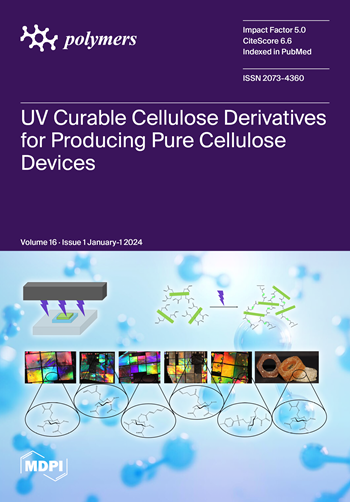乙二醇二环戊烯醚丙烯酸酯改性有机硅膜的抗菌载银性能。
IF 4.9
3区 工程技术
Q1 POLYMER SCIENCE
引用次数: 0
摘要
本研究采用直接辐照法和预辐照法对硅酮膜(SR)进行接枝乙二醇二环戊烯醚丙烯酸酯(EGDEA)修饰,辐照剂量为10 ~ 50 kGy/h,辐照速率为10.8 kGy/h。包括TGA、DSC、接触角测量、力学测试、膨胀和FTIR在内的几种技术证实了EGDEA接枝到SR膜上。直接法接枝效率最高,为50 kGy。随后,将SR-g-EGDEA膜负载银进行微生物测试,显示出潜在的生物医学应用前景。本文章由计算机程序翻译,如有差异,请以英文原文为准。
Silicone Films Modified with Ethylene Glycol Dicyclopentenyl Ether Acrylate for Antimicrobial Silver Loading.
In this research, silicone films (SR) were modified by grafting ethylene glycol dicyclopentenyl ether acrylate (EGDEA) through gamma-ray irradiation using both direct and pre-irradiation methods at a dose rate of 10.8 kGy/h, with doses ranging from 10 to 50 kGy. Several techniques, including TGA, DSC, contact angle measurement, mechanical testing, swelling, and FTIR, confirmed the grafting of EGDEA onto SR films. The highest grafting efficiency was achieved at 50 kGy using the direct method. Subsequently, SR-g-EGDEA films were loaded with silver for microbial testing, showing promising results for potential biomedical applications.
求助全文
通过发布文献求助,成功后即可免费获取论文全文。
去求助
来源期刊

Polymers
POLYMER SCIENCE-
CiteScore
8.00
自引率
16.00%
发文量
4697
审稿时长
1.3 months
期刊介绍:
Polymers (ISSN 2073-4360) is an international, open access journal of polymer science. It publishes research papers, short communications and review papers. Our aim is to encourage scientists to publish their experimental and theoretical results in as much detail as possible. Therefore, there is no restriction on the length of the papers. The full experimental details must be provided so that the results can be reproduced. Polymers provides an interdisciplinary forum for publishing papers which advance the fields of (i) polymerization methods, (ii) theory, simulation, and modeling, (iii) understanding of new physical phenomena, (iv) advances in characterization techniques, and (v) harnessing of self-assembly and biological strategies for producing complex multifunctional structures.
 求助内容:
求助内容: 应助结果提醒方式:
应助结果提醒方式:


